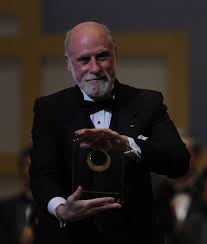Will our lumbering industrial age driven information age segue smoothly into a futuristic marvel of yet to be developed technology? It might. Or take quantum leaps. It could. Will information technology take off exponentially? It’s accelerating in that direction. The way knowledge is unraveling its potential for enhancing human ingenuity, the future looks bright indeed. But there is a problem. It’s that egoistic tendency we have of defending ourselves against knowing, of creating false images to delude ourselves and the world, and of resolving conflict violently. It’s as old as history and may be an inevitable part of life. If so, there will be consequences.
Who has ever seen drama/comedy without obstacles to overcome, conflicts to confront, dilemmas to address, confrontations to endure and the occasional least expected outcome? Just as Shakespeare so elegantly illustrated. Good drama illustrates aspects of life as lived, and we do live with egoistic mental processes that are both limited and limiting. Wherefore it might come to pass that we who are of this civilization might encounter an existential crisis. Or crunch into a bottleneck out of which … will emerge what? Or extinguish civilization with our egoistic conduct acting from regressed postures with splintered perception.
What’s least likely is that we’ll continue cruising along as usual.
Not with massive demographic changes, millions on the move, radical climate changes, major environmental shifts, cyber vulnerabilities, changing energy resources, inadequate clean water and values colliding against each other in a world where future generations of the techno-savvy will be capable of wielding the next generation of weapons of mass destruction.
On the other hand, there are intelligent people passionately pursuing methods of preventing the use of weapons, combating their effects and securing a future in which these problems mentioned above will be solved, and also working towards an advanced civilization.
It’s a race against time.
In the balance hangs nothing less than the future of civilization.
The danger from technology is secondary.
As of now, regardless of theories of international affairs, in one way or another, we inject power into our currency of negotiation, whether it be interpersonal or international, for after all, power is privilege, hard to give up, especially after getting a taste of it, and so we’ll quarrel over power, perhaps fight. Why deny it? The historical record is there for all to see. As for our inner terrors, our tendency to present false egoistic images to the world and of projecting our secret socially unacceptable fantasies on to others, we might just bring to pass what we fear and deny. It’s possible.
Meantime there are certain simple ideas that remain timeless: For example, as infants we exist at the pleasure of parents, big hulks who pick us up and carry us around sometimes lovingly, sometimes resentfully, often ambivalently, and to be sure many of us come to regard Authority with ambivalence. As Authority regards the dependent. A basic premise is that we all want something in a relationship. So what do we as infants want from Authority? How about security in our exploration of life? How about love? If it’s there we don’t have to pay for it. There are no conditions attached. Life, however, is both complicated and complex beyond a few words, and so we negotiate in the ‘best’ way we have at our disposal, which in the early stages of life are non-verbal intuitive methods that in part enter this life with us, genetically determined, epigenetically determined and in part is learned, but once adopted, a certain core approach becomes habitual, buried deeply under layers of later learned social skills, skills that we employ in our adult lives. These skills are however relatively on the surface. Hidden deep inside are secret desires, unfulfilled fantasies, hidden impulses that wouldn’t make sense in adult relationships if expressed openly in words.
It has been said repeatedly that crisis reveals character. Most of the time we get by in crisis, but we each have a ‘breaking point,’ meaning that under severe enduring stress we regress at a certain point, at which time we’ll abandon sophisticated social skills and a part of us will slip into infantile mode, not necessarily visible on the outside. It varies. No one can claim immunity. And acting out of infantile perception in adult situations can have unexpected consequences depending on the early life drama. Which makes life interesting. It also guarantees an interesting future.
Meantime scientists clarify the biology of learning, of short term memory, of long term memory, of the brain working as a whole, of ‘free will’ as we imagine it, but regardless of future directions, at this time we need agency on the personal and social level so as to help stabilize civilization. By agency I mean responsibility for one’s actions. Accountability, including in the face of dilemmas. Throughout the course of our lives from beginning to end we encounter dilemmas.
Consider the dilemmas the Europeans under German occupation faced last century. I use the European situation as an illustration or social paradigm, not to suggest that this situation will recur, nor to suggest that any one ethnic group will be targeted in the future, but I do suggest that if a global crisis hits, we’ll confront moral dilemmas, and so we can learn from those relatively few Europeans who resolved their dilemmas in noble ways, as opposed to the majority who did nothing to help the oppressed.
If a European in German occupied territory helped a Jew he or she and family would be in danger of arrest, torture and death. How about watching one’s spouse and children being tortured? On the other hand, if she or he did not help they would be participating in murder and genocide, and know it. Despite the danger, certain people from several European countries helped the Jews. According to those who interviewed and wrote about the helpers, (see references listed below) the helpers represented a cross section of the community, that is, some were uneducated laborers, some were serving women, some were formally educated, some were professionals, some professed religious convictions, some did not. Well then, what if anything did these noble risk takers have in common? What they shared in common was this: They saw themselves as responsible moral agents, and, acting on an internal locus of moral responsibility, they each acted on their knowledge and compassion and did the ‘right thing.’ It came naturally to them. But doing the ‘right thing’ in the face of life threatening dilemma does not come naturally to everyone. Fortunately it is a behavior that can be learned.
Concomitant with authentic learning, according to research biologists, is the production of brain chemicals that in turn cultivate structural modification in brain cells. A self reinforcing feedback system. In short, learning is part of a dynamic multi-dimensional interaction of input, output, behavioral change, chemicals, structural brain changes and complex adaptation in systems throughout the body. None of which diminishes the idea that we each enter this life with certain desires, potential and perhaps roles to act out, one of which for me is to improve myself.
Good news! I not only am, I become.
Finally, I list some 20th century resources that remain timeless to this day:
Millgram, S. Obedience to Authority: An Experimental View. Harper & Row. 1974.
Oliner, Samuel P. & Pearl. The Altruistic Personality: Rescuers of Jews in Nazi Europe. Free Press, Division of Macmillan. 1998
Fogelman, Eva. Conscience & Courage Anchor Books, Division of Random House. 1994
Block, Gay & Drucker, Malka. Rescuers: Portraits of Moral Courage in the Holocaust. Holms & Meier Publishers, 1992

